by Joy Livingwell
Frank & Vicky Dawley 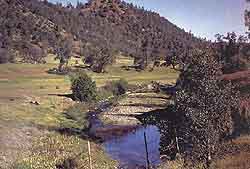 1980. Under conventional management, bare banks eroded during winter floods. Frank & Vicky Dawley 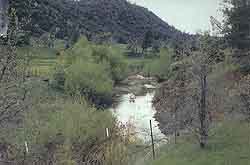 1995. Revegetated banks hold against floods. Joy Livingwell 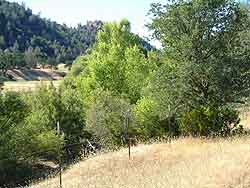 July 2002. The channel is now so heavily vegetated I couldn't see the stream. |
Frank, Vicky, and their son Tyler Dawley run the 4,000 acre (1,600 ha) Big Bluff Ranch outside Red Bluff, northern California, U.S.A. 150 years of conventional range management favored alien annuals so much they have replaced the native perennials in most areas. This created statewide problems with high runoff and flooding during the state's rainy winters.
Rainfall averages around 34" (850 mm), but varies from 12" to 72" (300-1,800 mm). The average rainless period is 6 months, from May through October.
In spite of the Dawley family's long-standing efforts to stabilize the channel of this stream using riprap and recontouring with a bulldozer, the bare banks eroded every winter. Conventional management addressed symptoms without dealing with the underlying problems.
Once the Dawleys adopted Holistic Management:
- Concentrated hoof action from their cattle created a good seed bed
- Adequate rest periods between grazings allowed perennial plants to establish
- Periodic grazing kept nutrients cycling and helped the revegetation process.
Away from the stream, good management is reducing runoff, but the recovery process is much slower. Vicky says, "We got good results in 10 years in our riparian areas. In other places where we've been managing closer to 20 years, we see less change."
When I visited in Dawleys July 2002, Frank took me to the stream downstream of the pictures above. Willows grow right up to the edge of water that flowed slowly among the stones.
Joy Livingwell 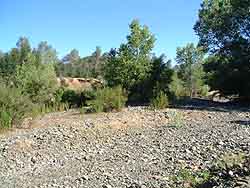 "If I hadn't bulldozed, this whole area would be full of trees the size of the big one at right," says Frank. Stream lies inside the line of small trees at left. July 2002. Joy Livingwell 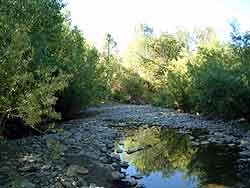 Willows grow right up to the edge of flowing water. This is just upstream of the area shown above. July 2002. |
"If I hadn't cleared part of the stream channel with a bulldozer, we'd have even more vegetation," Frank told me. "I was partway through when I went to a workshop on stream management. They said you should never bulldoze in stream beds because it destroys trees. When I got home I graded the edge of the area I was working on, then stopped."
Today the bulldozed area still has smaller trees and large gravel areas. The undisturbed area is thick with willows and sizeable trees.
"With Holistic Management, planned grazings, education, and a little thought, our 100-yard-wide gravelly creek beds are becoming riparian jungles -- thickets of cottonwoods, willows, vines, grasses, and all manner of debris. Our local Fish and Game biologist estimates that no fewer than two dozen species of vertebrates are utilizing the gravel bed, and over 160 the riparian jungle. Now the creek flows until September, and never becomes completely dry. A near term goal is to have trout in it again; a long term goal is for salmon to spawn in it."